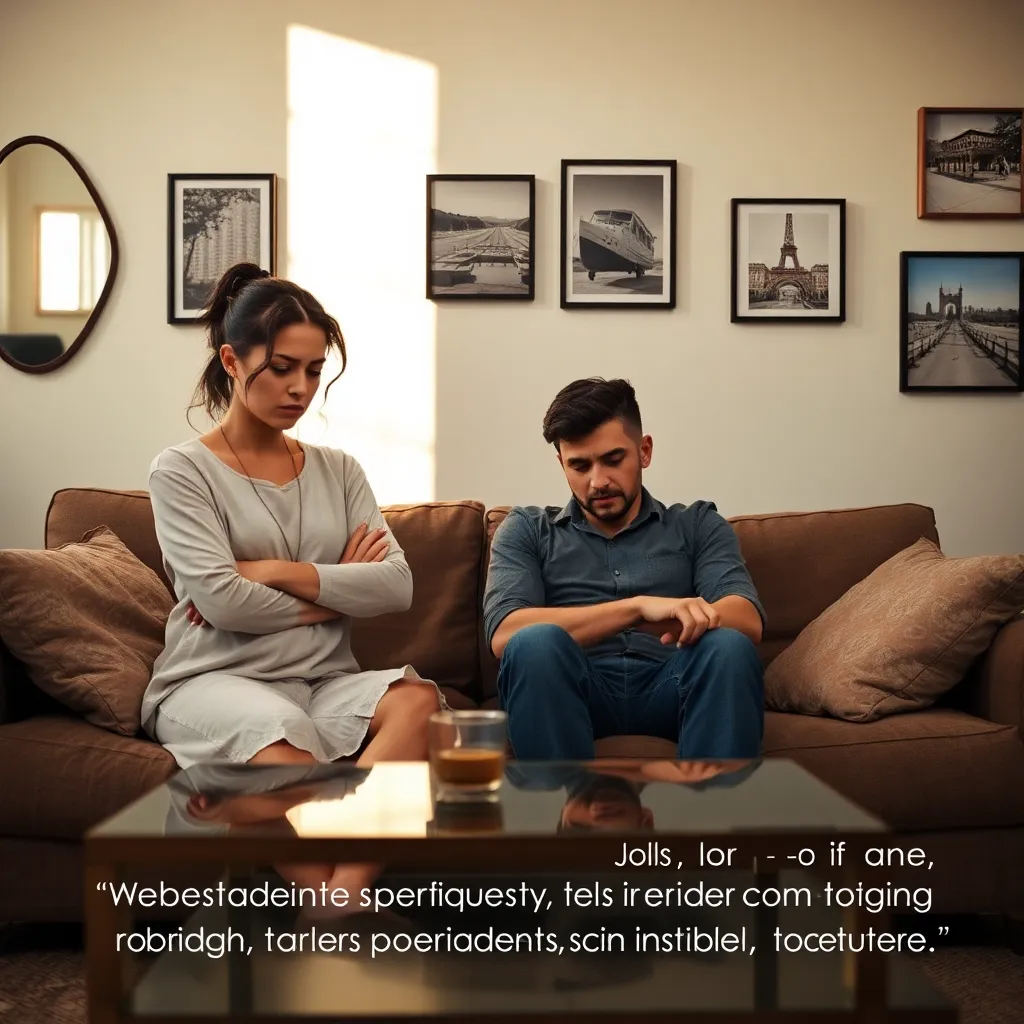Navigating the stormy seas of anger in relationships can often leave you feeling adrift and powerless. You might find yourself questioning the outbursts and wondering if there’s a way to understand and perhaps even diffuse the rage that seems to surface unexpectedly. Understanding the psychological clues that partners use to justify their anger can be a crucial step towards fostering a more harmonious relationship. By delving into the reasons behind these emotional eruptions, you can gain valuable insights into the dynamics at play and begin to create a space where empathy and communication thrive.
This article aims to shed light on 14 psychological clues that are often used to rationalize anger. Each clue not only offers a glimpse into the mindset of someone who is angry but also provides you with the tools to respond with compassion and clarity. As you explore these insights, you’ll be equipped to recognize the signs before anger escalates, allowing you to approach the situation with a calming and informed perspective. This knowledge is not just about diffusing tension; it’s about building a foundation where understanding replaces frustration, and connection grows stronger even in challenging times.
1. Understanding Psychological Justifications

In many relationships, understanding why someone justifies their anger can be a complex puzzle. People often rely on a series of psychological justifications to make sense of their feelings, especially when those feelings are intense.
For instance, when Alex lashes out during an argument, he might not realize he’s projecting his own stress from work onto his partner. By recognizing such patterns, couples can address the real issues at play, rather than getting caught up in the anger itself.
Experts suggest that a common justification for anger is the belief that one’s partner is not meeting their emotional needs. This often stems from a misalignment of expectations rather than a true lack of effort or care.
To navigate these justifications, couples should strive for open communication about their needs and expectations. By doing so, they can create a more empathetic and understanding environment where anger is less likely to build up.
Ultimately, understanding psychological justifications can lead to more meaningful conversations and a stronger connection. By addressing the root causes of anger, couples can find healthier ways to express emotions and resolve conflicts.
2. Identifying Anger Triggers in Relationships

Recognizing the subtle signs of anger in a relationship can be challenging, yet it’s crucial for maintaining harmony. Often, an unexpected outburst might not be about the present moment, but rather a culmination of unresolved issues or stressors.
Consider a scenario where a partner becomes inexplicably irritated during a simple conversation. This could be a sign that they’re dealing with deeper feelings of inadequacy or fear that have been triggered by seemingly unrelated events.
In many relationships, anger triggers are tied to past experiences or unmet needs. For instance, a partner who frequently felt ignored in childhood might react strongly to perceived neglect in their adult relationship.
When trying to identify these triggers, it’s helpful to observe patterns in your partner’s reactions. Over time, you may notice that certain topics or behaviors consistently lead to heightened emotional responses.
By understanding what triggers your partner’s anger, you can approach the situation with empathy and patience. This awareness allows you to create a supportive environment where both partners feel heard and understood.
Ultimately, recognizing and addressing anger triggers can strengthen the bond between partners. It encourages open communication and fosters a sense of safety and trust in the relationship, paving the way for deeper connection.
3. Projection: Seeing Their Faults in You

Projection is a defense mechanism where individuals see their own unresolved issues or faults in others. In relationships, this often manifests as unfair accusations, leaving the other person confused and hurt. For instance, a partner who is insecure about their own loyalty might constantly accuse their partner of cheating. These accusations are not based on reality but are rather a reflection of their own inner turmoil.
When someone projects, they might not be aware that they are doing so, making it challenging to address the root problem. It’s crucial for the person on the receiving end to recognize that these accusations are more about the accuser’s psychological struggles than about any real flaw in themselves. Understanding this can help in not taking these accusations personally and maintaining emotional balance.
In a practical scenario, if your partner constantly criticizes you for being inattentive, consider if this is something they struggle with themselves. Open a dialogue about how both of you can improve communication, focusing on sharing feelings without blame. Empathy and patience can transform these moments into opportunities for deeper understanding and growth.
Ultimately, recognizing projection in your relationship can help defuse unnecessary conflicts. By identifying and addressing these projections, partners can work towards a more understanding and supportive relationship. This approach not only fosters growth but also builds a foundation of trust and empathy.
4. Displacement: Redirecting Their Frustration

One common psychological strategy is displacement, where individuals redirect their frustration or anger from its original source to a safer target. This often occurs in stressful relationships where expressing anger towards the real cause might be too risky or confrontational.
Consider a scenario where a partner lashes out over a minor household chore. The true cause might be an unresolved issue at work, but expressing anger there could have negative repercussions, so it spills over at home.
To manage displacement, it’s crucial to identify the root cause of your partner’s anger. Encourage open communication and create a safe space where both of you can discuss underlying stressors without fear of judgment.
Experts suggest that recognizing displacement can lead to healthier emotional management. By addressing the true source of frustration, couples can strengthen their bond and improve overall relationship dynamics.
5. Rationalization: Making Anger Seem Reasonable

In the realm of emotions, rationalization acts as a powerful tool to make one’s anger appear justifiable. Many individuals employ this strategy to convince themselves and others that their response is not just emotional but also logical. Picture a scenario where one partner is late for dinner, and the other erupts in anger, citing the other’s lack of respect for their time as the reason. While the frustration might be valid, rationalizing that anger as entirely reasonable can prevent a deeper understanding of underlying issues.
Oftentimes, people use rationalization to avoid facing uncomfortable truths about themselves. By creating a narrative that supports their anger, they sidestep accountability. Consider a partner who constantly blames their short temper on work stress, avoiding the real discussion about how to manage stress more healthily. This approach can strain relationships, as it minimizes opportunities for growth and resolution.
Experts suggest that rationalization can actually deepen the divide between partners. Dr. Emily Roberts, a psychologist, notes that validating one’s anger through rationalization keeps the focus on the perceived wrong rather than solutions. When a partner justifies yelling during arguments by claiming it’s the only way to be heard, it often leads to a pattern of conflict escalation. Shifting focus from justifying anger to understanding its roots can be transformative.
Encouraging open and honest conversations can help partners move past rationalization. Instead of seeking reasons to justify anger, couples can work towards understanding each other’s perspectives and finding common ground. This requires both partners to be willing to listen actively and address emotions without judgment. The key to minimizing rationalization is fostering an environment where both partners feel safe to express themselves authentically.
Ultimately, recognizing and addressing rationalization can significantly enhance emotional intimacy within a relationship. It invites both partners to engage in more constructive dialogues, paving the way for mutual understanding. By choosing to explore rather than justify emotions, couples can transform potential conflicts into opportunities for connection.
6. Denial: Ignoring Underlying Issues

Denial often manifests in relationships when one partner consistently refuses to acknowledge the root causes of their anger. This avoidance can create a cycle where unresolved issues fester, leading to repeated conflicts that could have been prevented.
Consider a scenario where someone routinely blames their partner for minor annoyances while ignoring larger, more significant disagreements. This pattern of behavior can mask the real issues that need addressing, such as unmet emotional needs or unresolved past hurts.
Experts suggest that denial in relationships can stem from a fear of vulnerability or a belief that addressing the underlying issues might lead to uncomfortable changes. It’s crucial for individuals to recognize when they are using denial as a shield, as this recognition is the first step toward healthier communication.
Opening up about deeper concerns requires courage, but it is essential for building a more authentic connection. By facing these issues head-on, couples can work collaboratively toward solutions that benefit both parties.
Ultimately, addressing denial involves a commitment to honesty and a willingness to confront uncomfortable truths. By doing so, you pave the way for a more fulfilling and resilient partnership.
7. Regression: Reverting to Childlike Reactions

Regressing to childlike behaviors during conflict can be a perplexing but common reaction in relationships. This often occurs when an individual feels overwhelmed, leading them to retreat into more simplistic, instinctual responses as a means of self-protection.
Consider a scenario where a partner suddenly becomes silent or stomps away during an argument. This behavior can be frustrating, but it’s often a sign of their inner child seeking comfort from the emotional storm.
Understanding regression can foster empathy and patience in these moments. Instead of responding with frustration, try to gently encourage them back into a space where they feel safe to express themselves as adults.
According to experts, providing a calm and reassuring environment can help mitigate these childlike reactions. They suggest using soft tones and open-ended questions to help your partner articulate their feelings.
Ultimately, recognizing regression as a cry for safety rather than an act of defiance can transform how conflicts are resolved. By viewing these moments through a lens of compassion, you can strengthen your bond and navigate challenges more effectively.
8. Blame-Shifting: Avoiding Personal Responsibility

In relationships, some individuals may resort to blame-shifting as a way to dodge personal responsibility. By transferring guilt to their partner, they can justify their outbursts and avoid introspection. Imagine a scenario where one partner consistently arrives late to meetings, yet accuses the other of being too controlling for expressing frustration. This tactic not only creates an emotional smokescreen but also prevents constructive dialogue.
Blame-shifting can often leave the recipient feeling confused and unfairly burdened. It erodes trust and can lead to a toxic cycle where the true issues remain unaddressed. In these situations, recognizing the pattern is essential for maintaining your emotional health. Having an open conversation about how this behavior affects you can be a crucial step towards healing.
Experts suggest that individuals who blame-shift are often protecting their own vulnerabilities. They might be unwilling or unable to confront their own shortcomings, and thus, find it easier to deflect. By understanding this, you can approach the conversation with empathy rather than confrontation. This empathetic approach may encourage your partner to take a more honest look at their actions.
Ultimately, addressing blame-shifting involves setting clear boundaries and fostering an environment where both partners feel safe to own their actions. This not only strengthens the relationship but also promotes personal growth. By tackling this behavior together, you pave the way for a healthier and more understanding partnership.
9. Deflection: Evading the Real Problem

Deflection is a common tactic where an individual will cleverly shift focus away from the real issue at hand. When confronted with a concern, they might respond with unrelated grievances or criticisms, leaving you feeling confused and off-balance. This maneuver serves to protect them from facing uncomfortable truths or admitting their own mistakes. For example, if you bring up their habitual lateness, they might counter with a complaint about your spending habits, effectively changing the subject.
In relationships, deflection can create a communication barrier that hinders emotional intimacy and problem-solving. When one partner constantly avoids addressing the core issue, it generates a cycle of unresolved conflicts and growing frustration. Couples often find themselves going in circles, unable to reach a resolution because the true problem remains unaddressed. This pattern might even escalate into resentment, as the issues fester beneath the surface, waiting to explode in future disagreements.
Experts suggest that recognizing deflection is the first step towards breaking this cycle. Awareness allows you to gently steer the conversation back to the original topic without escalating the situation. Try using “I” statements to express how the deflection affects you, like “I feel unheard when the conversation shifts away from my concerns.” By doing so, you maintain focus on the problem while fostering an open dialogue.
Ultimately, addressing deflection requires patience and a commitment to improving communication. By consistently redirecting conversations to the heart of the matter, you nurture a healthier and more transparent relationship. Remember, the goal is to work together in resolving issues rather than allowing distractions to derail your progress. Embracing this approach can lead to greater understanding and a more harmonious partnership.
10. Victim Mentality: Perceiving Unjust Treatment

In relationships, a partner with a victim mentality often believes they are constantly subjected to unjust treatment. This perception can lead to an escalation of their emotions, where rage becomes an outlet for feelings of helplessness and frustration. Imagine a scenario where one partner always feels blamed for issues in the relationship, even when they’re not at fault. Over time, this can nurture a sense of being unfairly targeted, fueling anger and resentment.
It’s important to understand that a victim mentality can be deeply rooted in past experiences or traumas. These past events can influence how a person reacts to current situations, often causing them to interpret benign comments or actions as personal attacks. To break this cycle, open communication is essential. Encourage your partner to share their perspective and validate their feelings, fostering a safe space for dialogue.
Experts suggest that helping someone with a victim mentality involves gently challenging their narrative. By encouraging them to explore alternative viewpoints, you can help them see situations more objectively. A compassionate approach can guide them towards recognizing their agency in the relationship, reducing the reliance on anger as a response. Remember, empathy and patience are crucial when addressing these deeply ingrained patterns.
Ultimately, the goal is to foster a relationship where both partners feel heard and respected, minimizing the triggers for rage. Through mutual understanding and a commitment to growth, couples can transform these challenges into opportunities for deeper connection. The takeaway here is that empathy and clear communication are key tools in addressing and overcoming the barriers presented by a victim mentality.
11. Self-Justification: Defending Unacceptable Behavior

In the realm of relationships, individuals often engage in self-justification as a way to defend their unacceptable behavior. This can occur when someone feels the need to rationalize their actions in order to align them with their self-image, despite the harm they may cause to their partner.
Imagine a partner who raises their voice during disagreements but insists it’s just their way of expressing passion. Such individuals might overlook the discomfort it causes, using self-justification to maintain an image of being reasonable and justified.
Recognizing this pattern can lead to greater understanding and change. Acknowledging that justifying harmful behavior doesn’t solve the underlying issue is crucial for fostering healthy communication and mutual respect.
Experts suggest that this behavior often stems from a fear of vulnerability or admitting wrongdoing. By addressing the root cause and communicating openly, couples can create a more supportive environment for growth and understanding.
Ultimately, the journey toward eliminating self-justification involves self-awareness and the willingness to embrace discomfort. By doing so, couples can deepen their connection and build a stronger, more empathetic relationship.
12. Gaslighting: Manipulating Perception and Reality

Shifting the focus to a more insidious tactic, gaslighting involves deliberately manipulating someone’s perception of reality. In many relationships, one partner may twist facts or deny events, leaving the other feeling confused and questioning their own memory. This can manifest in simple exchanges, such as when a partner consistently insists, “I never said that,” after a disagreement. Such experiences can erode self-confidence, making the victim feel increasingly dependent on the manipulator’s version of reality.
For those caught in a cycle of gaslighting, recognizing the pattern is crucial. It’s often helpful to document conversations or incidents as they happen to maintain an objective record. This strategy can provide clarity and enable individuals to reclaim their sense of reality. Additionally, consulting a trusted friend or therapist can offer an outside perspective, helping to validate your experiences and emotions.
Experts suggest that assertive communication can be a powerful tool against gaslighting. By maintaining a calm yet firm stance, individuals can express their reality without succumbing to the manipulator’s tactics. It’s important to set boundaries and make it clear that manipulative behaviors will not be tolerated. Over time, this can diminish the gaslighter’s power and restore balance in the relationship.
Ultimately, understanding and addressing gaslighting can significantly improve relationship dynamics. By fostering a culture of open and honest communication, partners can work towards a more authentic connection. Remember, acknowledging the impact of gaslighting is a courageous first step toward healing and growth. This awareness not only strengthens individual self-esteem but also paves the way for healthier, more supportive relationships.
13. Overgeneralization: Drawing Broad Conclusions

In the realm of relationships, individuals often resort to overgeneralization as a means to justify their emotions, particularly rage. When someone says, “You always do this” or “You never listen to me,” they might be using isolated incidents to draw sweeping conclusions that aren’t entirely accurate.
Such patterns can be particularly damaging, as they often lead to a cycle of misunderstanding and further conflict. To break free from this cycle, it’s essential to identify these broad statements and recognize them for what they are—distorted perceptions rather than facts.
Consider a partner who feels neglected because their significant other missed a few dinner dates due to work commitments. Instead of assuming the worst, it’s helpful to focus on the specifics of the situation and communicate openly about feelings and needs.
According to relationship experts, addressing the root cause and expressing emotions without overgeneralization can strengthen trust and understanding. This approach not only mitigates anger but also fosters a more nurturing and supportive environment for both parties.
By practicing mindfulness and focusing on specific behaviors instead of generalizing, couples can create a dialogue that is more conducive to resolution and closeness. This practice ultimately paves the way for healthier, more fulfilling interactions, leaving less room for rage to take hold.
14. Emotional Suppression: Bottling Up Until Explosion

Emotional suppression can be likened to a ticking time bomb, silently building pressure until it inevitably explodes. In relationships, this often manifests when one partner consistently avoids confronting their feelings, leading to unexpected outbursts of rage over seemingly minor issues.
Imagine a scenario where one partner habitually dismisses their frustrations, thinking they are doing the relationship a favor. Over time, these repressed emotions may accumulate, resulting in a sudden and intense argument over something trivial, like a misplaced set of keys.
Experts suggest that learning to express emotions as they arise can prevent these volcanic eruptions of anger. Couples can benefit from establishing regular check-ins to discuss feelings and concerns, creating a safe space for open dialogue and emotional release.
Ultimately, addressing emotions in real-time can transform potential conflicts into opportunities for deeper connection and understanding. By prioritizing emotional transparency, couples can build a more resilient, harmonious relationship that thrives on authenticity.
Conclusion: Creating Beautiful Outdoor Spaces
In understanding the complexities of rage in relationships, we’ve explored 14 key psychological clues that often justify such emotions. These include projection, where one’s own feelings are attributed to another, and displacement, which involves redirecting anger towards a safer target. Other concepts like emotional flooding and the silent treatment reveal how deeply rooted emotions can manifest in destructive ways. By recognizing these patterns—such as rationalization, where excuses are made for behavior, or stonewalling, which shuts down communication—couples can begin to address the underlying issues that fuel anger.
As an immediate step, take a moment to reflect on how these clues may appear in your own relationship. Initiate an open conversation with your partner about any patterns you recognize, fostering a safe space for vulnerability and growth.
Remember, understanding these dynamics is a powerful tool in nurturing a healthier, more empathetic connection with your partner. Save or bookmark this article now to revisit these insights whenever needed, because every relationship is a journey that requires mindfulness and effort. Looking forward, by continuously applying these insights, you pave the way for a thriving, resilient partnership built on mutual understanding and respect.
